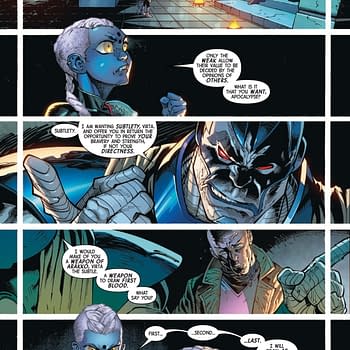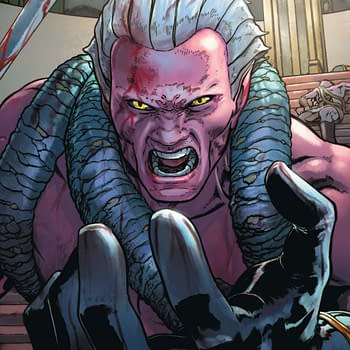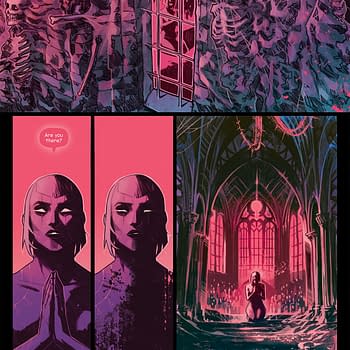Posted in: Comics | Tagged: Comics, expo, image
The Not Quite Secret Origin Of Image Comics
Peter S. Svensson is embedding on the West Coast at the Image Comics Expo. If you see him, feed him chips.
The second day of Image Comics Expo featured the Image Founders panel, celebrating 20 years of Image Comics. Rob Liefeld, Jim Valentino, Marc Silvestri, Todd McFarlane, Robert Kirkman and Erik Larsen spoke about the history of Image Comics. Larsen was late to the panel, which seemed somewhat appropriate that a celebration of Image history would involve tardiness in some form or another. Kirkman questioned the reasoning behind having him attend a panel about the formation of Image, given that he was 14 when it all started. McFarlane confirmed that there would be no surprise last minute appearance by Jim "DC" Lee.
Liefeld began telling the story of how Image began with him, Erik Larsen and Jim Valentino talking with the publisher of Malibu comics about the prospect of their starting a new comics line. How he wasn't at all frustrated or disappointed with his tenure at Marvel as much as that he was more looking forward to doing new stuff for the future. More to the point, that Liefeld's deep friendships with his fellow creators cultivated by hanging out at cons and a series of length phone calls to McFarlane and Valentino were the basic foundation of what would become Image. The enthusiastic young Liefeld may have overdone it. "You call me more than my mother." quipped McFarlane back in the day. "Message received." was Liefeld's sheepish reply.
While still on New Mutants, Liefeld placed an ad in Comic Buyers Guide for a potential new book of his: "Executioners." Marvel's legal team swiftly sent him a stern cease and desist. Liefeld was 22 at the time. The desire to do his own book remained, and along with McFarlane who had been wanting to do Spawn, as well as Valentino who had previous publishing experience, the germ of an idea began to form. Liefeld ended up using a X-Men conference Marvel arranged, which flew out the main artists and writers to discuss future issues as a way to talk to his fellow friends and creators. Yes, much of the foundation of Image Comics ended up occurring on Marvel's dime.
The core of Image came from the realization that rather than having Larsen, McFarlane, Liefeld and Valentino do four books on their own, they could join forces and do four books together. McFarlane explained that the core of their plan was to get Jim Lee, Marvel's golden boy, on board. For while he and Liefeld already had the "Marvel's Bad Boys" label, he knew that someone as respected and genuine as Jim Lee joining would send a clear message. They scheduled a meeting in New York that coincided with an auction Lee would be attending, and managed to get him on board. Whilce Portacio was then brought on board by Lee. The plan was then to go to Marvel the next day and announce that they were leaving. Silvestri was a last minute addition, having been bumped into at the hotel they were staying at in New York, and approached with the information that he'd have to decide whether or not to quit his current title and go run off and try something unexplored.
Immediately after the founding Image partners went to Marvel and gave notice of their departure, they went across the street to DC. At this point, Jim Lee had yet to do any work for DC, and upon seeing Lee enter the building all the editors believed that they had just landed a major prize in a defecting Jim Lee. And so they let the DC staffers work themselves into a lather for close to an hour before explaining that they had just stopped by to say that while they were no longer working for Marvel, they also had no plans to work for DC either. It was merely a courtesy visit. McFarlane explained that DC tried to get them to sign on by explaining how they had created new terms for creators which would make their lives better. McFarlane asked how many creators were consulted in the drafting of those terms, and got no response.
At that point, they went to Marc Silvestri's house for the First Image Meeting. Jim Valentino had some prior self-publishing experience, and it was his idea to hire Malibu Comics to handle the infrastructure and logistics of running a comic company for that first year until they had gotten on their feet. Valentino made it very clear, the deal was that Image hired Malibu not the other way around. Image was not an imprint.
The conversation swayed to the topic of regretting any work done for Marvel or DC. McFarlane explained that when he was a freelancer for the Big Two he went out of his way to only design or create characters when necessary. If a script called for a new mad scientist villain, he'd grudgingly create one. But he never went out of his way to make a new villain. Which is why his run on Spider-Man just used established villains. "But cooler." McFarlane added. Creating Savage Dragon at Marvel would never have been a possibility. Spawn at Marvel might have been, though McFarlane never entertained the idea because it meant that the possibility of him losing the character would come up. That an editor would reassign say Joe Banana to take over.
McFarlane tried to segue into a topic that would pull Kirkman into the conversation, explaining that while Image as an artist-driven endeavor has succeeded where many writer-driven attempts to create new lines such as Bravura from Malibu Comics did not. Liefeld laughed at hearing McFarlane say the word "Bravura" for the first time in decades. McFarlane quipped that "Bravura" was so obviously a name chosen by writers. He continued to explain that because an artist can only focus on one book at a time, it means that if you want to follow them you have to try their creator-owned work. People bought Spawn not because of the character, as they had no way of knowing who he was before picking up that first issue. They bought it because they liked his art and that's where it would be now. He then had to make sure the storytelling was compelling enough to keep them coming back. But a writer can and will do multiple books, and thus if a writer is doing Batman and Wolverine as well as a creator owned title, fans of theirs are just going to buy the mainstream work and not pick up their independent stuff. Kirkman became a partner at Image once he came to that realization and left Marvel to focus on Image fulltime. "You can't have your cake and eat it too." said McFarlane.
Kirkman quipped that he owed so much of his success to Image, and that the deal they offered him is making his kids fat. (He would later clarify that his kids are actually unexpectedly thin.) He went on to explain that Image is currently the best source of new talent, using the tale of Jonathan Hickman as an example. Hickman got started with a blind submission, sending in comics he'd done to get published with no prior experience. Two years later he's "writing every Marvel book worth reading." He later explained that he feels 2012 will be a huge year for Image, as he's seen conditions get worse for creators at DC and Marvel. Image is a launching point for new talent, who get the best deal in the comics, specifically the same deal that the founders established 20 years ago. You keep your rights.
McFarlane expounded on how the most frustrating thing he's seen from people submitting to Image is that they give up when seeing that Image doesn't pay you up front. "They let (the lack of) $1000 keep them from making $1,000,000!" He elaborated that fortune favors the bold, and that if you can't find a way to survive for the 90 days until you get the rewards of selling your first comic from Image, you're not trying hard enough.
Silvestri went on to explain how the core of Image is that it was founded by seven lunatics. "The dysfunction is the function." He explained that it wasn't as horrifying a challenge as it may have seemed, as each of them continued to get calls from DC and Marvel asking if they'd want to return months into Image's publication. There was always the safety net of returning to the Big Two, even if it would have been a personal loss of face to accept it. Even so, Image revolutionized the comics industry based on an idea of Rob Liefeld's when he was 22.
"Image could survive without Spawn. … We could all get hit by a bus and Image would continue." explained McFarlane, proud that he'd created something that will outlast him. He plans to have Spawn be published under Image until the day he dies, expects that Larsen will continue to do Savage Dragon after that (as he believes Larsen will outlive him) and that as long as one person keeps it alive, Image will never die. McFarlane then took the time to congratulate Erik Larsen for his dedication to comics, and that rather than going into all sorts of multimedia works, he just wanted to do comics the way he wanted.
Marc Silvestri used this time to draw a Savage Dragon fin and place it above McFarlane's head. Seriously.
The floor was opened to questions. The first fan asked about whether the Image Founders still talked to each other as friends. Kirkman pointed out that he's gotten amazing advice on how to deal with Hollywood from McFarlane and Liefeld, both of whom have had long histories. Liefeld immediately pointed out that for all his experience, he has gotten nothing produced. Larsen agreed that these are the first people he'd call if he needed advice on anything. Silvestri told the story of how now, comic creators get a bit more respect in Hollywood than they used to. He used the story of how the creative team of the Witchblade TV series was incredibly dismissive and patronizing to him as the "comic book guy." Liefeld admitted that he'd fall asleep at the business meetings, but still felt that the core of Image was their camaraderie. The idea that Robert Kirkman is like their surrogate child came up.
The next fan asked about how Image Comics get produced into TV and movies. McFarlane explained that he wears two hats, one as the owner of Spawn, one as an Image partner. But as Image doesn't have any creative rights to the series they publish, they have no control over the process. Image will gladly advise if asked, but that's about it. Larsen elaborated, in that Image works as a means for producers to get in touch with the creators. Mainly just by forwarding them the pertinent contact info. "I'm pissed that I don't own a piece of Walking Dead!" joked Silvestri.
Silvestri answered the next fan's question of whether any of the panelists regretted creating characters for DC or Marvel by admitting that he had almost pitched CyberForce as an X-Men spinoff in that X-Conference so long ago, and got preemptively shushed by Liefeld before he could do so. Larsen regretted giving Marvel the distinct look of Cardiac. Kirkman gleefully admitted that he'd twice attempted to pitch a Cardiac project to Marvel because he was so impressed with the character. Liefeld had no regrets, as he feels that Cable and Deadpool need to be part of the X-Men's milieu. He came up with tons of characters, mainly because he was unimpressed with the caliber of the book he had been assigned. "Todd and Erik got to do Spider-Man! I got put on a title that had just featured Bird-Brain, who looks like a giant Big Bird!" He went on to explain that it was the perfect book for him, as he got to make a clear break from what had gone on before in a way that he wouldn't have been able to do on a more high profile title. Liefeld comes up with so many characters that it's okay if he gave a bunch to Marvel.
Kirkman interjected that he learned that the streets leading towards Image's HQ had names that Liefeld used in Youngblood, such as Katella Ave. Liefeld agreed that the Puma came from him looking at car names. McFarlane explained that sitting in the car waiting for his wife to finish shopping was how he noticed a sign that said "No Parking. Violators will be Towed" and well, you get the idea.
The next question brought up the much delayed Image United, much to the chagrin of the panelists who had all been hoping to not have to answer any questions about it. While several pages for the next two issues exist, there's no word, no date. McFarlane said that when he heard the original proposal, he said "It's going to be fucked." knowing that this would be a nightmare.
McFarlane answered the final question regarding future animation based on Image properties in a way that scared Kirkman, by admitting that the two of them were in discussions with Hollywood in regards to their mutual property Haunt. It seemed that Kirkman hadn't been expecting that to become public yet.
The panel finally ended. The Image Founders thanked the audience for having supported them and made this all possible.
Whilce Portacio said absolutely nothing the entire time.
Peter S. Svensson writes for Bleeding Cool, manages a comic shop in San Jose and is producing a steampunk-inspired production of A Midsummer's Night Dream.














